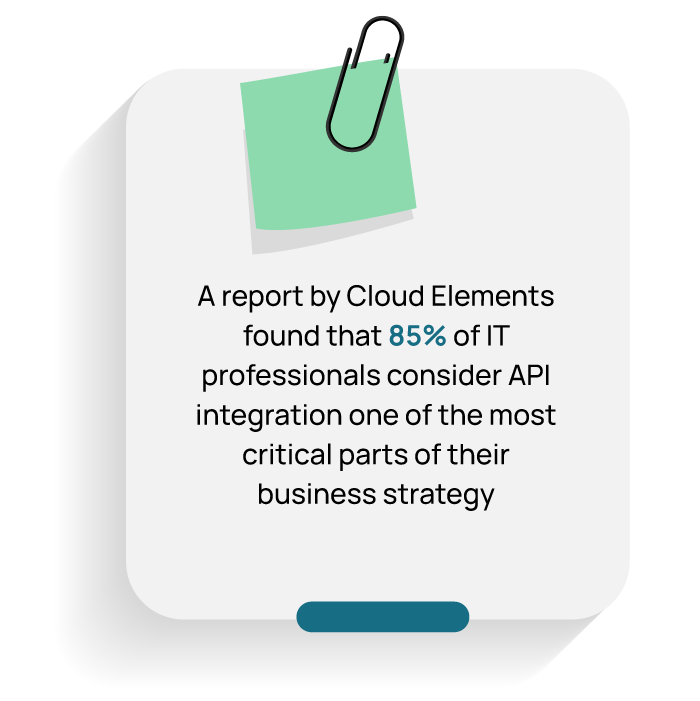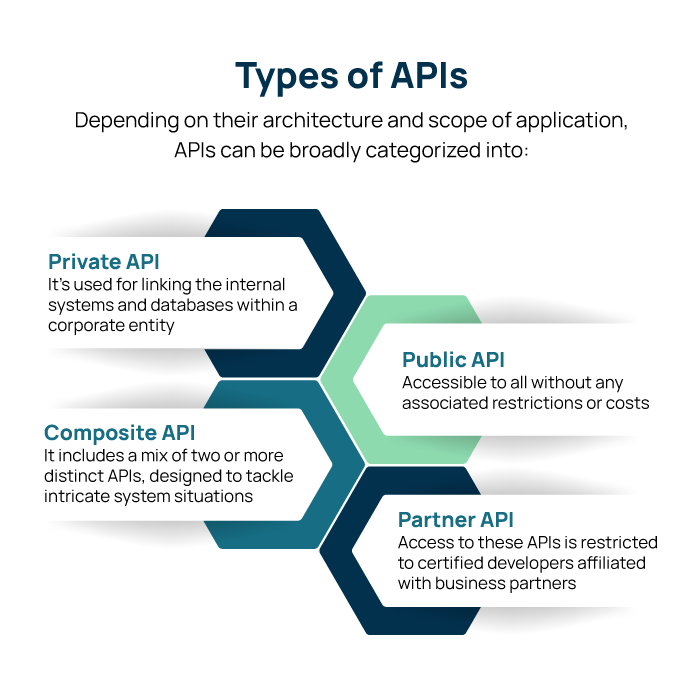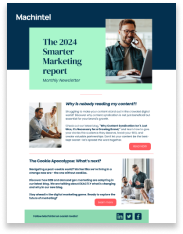Mastering API-driven Content Strategies for Marketing Success
Discover the power of modern marketing technologies with the integration of API-driven content strategies and headless CMS. Learn how this fusion transforms content creation and distribution.
Significance of APIs in Marketing
An Application Programming Interface (API) is a digital tool that enables marketing software to interact seamlessly, facilitating the exchange of data and commands based on predefined rules.
In digital marketing, APIs have gained utmost importance as they allow marketing platforms to integrate with web servers and other applications. This capability ensures the efficient management of vast datasets and adapts to the dynamic needs of consumers and businesses alike.

[Source: Brainium]
With APIs, marketing tools stay interconnected and have the capacity to adopt new features, significantly enhancing their value to marketers. The necessity for APIs in marketing strategies stems from the varied needs of businesses and their target audiences, emphasizing the need for a well-thought-out approach to their incorporation into marketing ecosystems to boost conversion rates.
APIs operate on a client-server basis, with the marketing application acting as the client that initiates requests. These requests are processed by a server, which then responds with the relevant data. This exchange allows marketing teams to automate and streamline their campaigns, data analysis, and customer engagement processes. The specifics regarding the API's functionality, availability, and any legal or operational limits are typically outlined in agreements between the service providers, ensuring a clear framework for their use in marketing initiatives.

Leveraging APIs and Headless CMS in Modern Marketing
The evolution of content management systems (CMS) toward a headless architecture marks a significant shift in digital marketing strategies.
Traditional versus Headless: CMS Evolution
A headless CMS, unlike traditional CMS platforms, separates the content repository (back end) from the presentation layer (front end). This means that, instead of the tightly coupled structure of traditional CMS, where content creation and delivery are intertwined within a single system, a headless CMS decouples these elements. It enables content to be created, managed, and stored independently of the methods and platforms on which it will be displayed.
While traditional CMS platforms dictate both the management and display of content through a unified, integrated system, a headless CMS adopts a more flexible approach. It provides content as a service through APIs, empowering developers to fetch and showcase content across a multitude of digital channels, ranging from websites and mobile apps to IoT devices, without being restricted by the limitations of any particular frontend technology.
API-Enabled Headless CMS: A Leap Forward
This architectural shift enhances marketing strategies in the digital era by leveraging APIs and headless CMS. It not only ensures software interoperability and the flexibility of API content delivery across different channels and devices but also allows for the personalization of marketing efforts. Utilizing detailed customer data and the adaptability of a headless CMS, marketers can refine operations, quickly adapt to emerging trends, and offer customized experiences.
Integrating headless CMS with advanced marketing strategies facilitates streamlined operations, maintains marketing initiatives' agility and relevance, and promotes customer engagement and brand loyalty. Whether opting for the integrated approach of a traditional CMS in certain scenarios or the modular, best-of-breed strategy that headless CMS offers, this integration caters to varying preferences and needs, optimizing digital marketing endeavors.
Selecting the Right Engine for an API-Driven CMS
Choosing the right engine for an API-driven CMS is a pivotal step in the modern approach to website development, as it enhances flexibility and efficiency in managing digital content.
It’s essential to articulate the specific functionalities and features that the CMS must possess. Headless CMS engines is diverse, offering a plethora of options.
Its key functionalities include:
- Content version control
- Streamlined approval workflows
- Varied content categorization systems
- Automated notifications
- Scheduled content publication
- SEO optimization capabilities
- Social media integration
These functionalities form the cornerstone of a CMS adept at managing API-powered digital content across platforms.
Understanding the urgency and development timeline of each desired feature is critical. Headless CMS engines, while sharing a core set of features, also present unique functionalities that may be considered premium and thus come with additional costs. The decision-making process involves balancing the immediate need for certain features against the feasibility of developing them in-house versus the investment in premium, ready-made solutions.
The next step involves a thorough examination of the available headless CMS engines.
This selection process is influenced by a range of factors including:
- Desired feature set
- Budgetary constraints
- Ease of integration with existing systems
- Preferred programming languages
- Targeted social media channels for integration
- And, the overall timeline for the CMS deployment
This approach helps in shortlisting a few headless CMS engines that align with the project’s specific requirements.
Finalizing the choice of a headless CMS engine is a collaborative effort between marketing and development teams. This involves a detailed evaluation of the shortlisted engines, focusing on customization flexibility, quality of API documentation, the extent of custom development required, and additional features such as auto-backup, content encryption, and media compression. For the marketing team, considerations such as cost versus value, development and customization timelines, availability of a dedicated content management panel, and the verification of key functionalities like workflow management and access management are paramount.
How API-based Headless CMSs Transform Digital Content Management
The transformation of content management through API-based headless CMS streamlines digital strategies by separating content creation from its presentation. It enables quick updates and broad distribution across platforms such as websites and mobile apps, enhancing flexibility and impact. This approach revolutionizes management, offers personalized experiences, and improves online visibility.
Some of the key advantages of API-based Headless CMS are discussed below:
Omnichannel Content Delivery
Headless CMS facilitates businesses in disseminating their content seamlessly across a multitude of digital platforms, including websites, mobile applications, IoT devices, and beyond. This integration ensures a cohesive and enhanced user experience across all touchpoints.
Personalized User Experiences
By leveraging APIs, marketing dynamics can be enhanced, making them more effective and user-centric through headless CMS personalization, which sources and delivers content that resonates with individual user preferences and behaviors.
Agility in Campaign Deployment
The decoupled architecture of headless CMS empowers marketing teams with the agility to swiftly launch new campaigns or amend existing content. This flexibility accelerates the pace of content updates and deployment, enabling marketers to respond promptly to market trends or customer needs.
Enhanced SEO and Website Performance
Headless CMS is instrumental in improving SEO outcomes and the overall performance of websites. Its structure is conducive to faster page loads and better search engine visibility, which are critical factors in the competitive arena of digital marketing.
Trends in API-driven Content Strategies
API-driven content strategies are swiftly transforming, shaping the future of digital marketing and operational approaches.
Let’s take a look at some of the emerging trends:
Federated API Management
There's a growing trend toward using federated API management. This is important because it helps manage APIs in a unified way across different systems, which is especially useful for medium to large businesses.
AI-Powered API Automation
Artificial intelligence plays a crucial role in creating and managing APIs. It helps make APIs smarter, allowing for better customization, smarter predictions, and improved security.
Hybrid Integration Platforms
A shift has been witnessed toward using hybrid platforms that handle both API management and integration. These platforms bring together the management of the API's entire life cycle with the ability to integrate data and applications.
API-Driven Strategies
Embracing API-driven strategies can substantially lower costs, accelerate entry to market, and improve digital interactions. Businesses aiming to deploy this approach should prioritize partnering with API-focused vendors, optimizing their API usage, and appreciating the value of headless APIs in content management.
Top API-driven Strategies for Content Marketers
Developing API-driven content strategies for marketing centers on utilizing APIs to efficiently and effectively create, distribute, and manage digital content. This approach enables the personalization of content for the audience, automates the distribution process, and enhances the relevance of content by integrating a variety of data sources and services. When implementing such a strategy, it is important to consider the technical integration challenges, compliance with data privacy regulations, and the overall impact on user experience. Here are several strategies to consider:
Content Personalization
- Use customer data APIs to fetch user preferences, past interactions, and behavioral data to create personalized content experiences.
- Implement machine learning APIs to analyze user data and predict content preferences, improving content recommendations.
Automated Content Distribution
- Integrate social media APIs to automate content sharing across multiple platforms, ensuring broader reach and engagement.
- Use email marketing APIs to automate email campaigns with personalized content, improving open rates and engagement.
Dynamic Content Creation
- Leverage APIs from news services, blogs, or content platforms to fetch and display real-time content relevant to your audience.
- Use weather, location, or event APIs to create dynamic content that changes based on the user's current context or environment.
Enhanced User Experience
- Integrate multimedia APIs (e.g., video, audio, images) to enrich content with interactive and engaging elements.
- Utilize translation and localization APIs to offer content in multiple languages, thereby expanding global reach.
Data-Driven Insights
- Implement analytics APIs to track content performance across different channels, gaining insights into what works best for the audience.
- Use these insights to refine content strategy, focusing on the most effective topics, formats, and distribution channels.
Content Syndication
- Use APIs to syndicate content to partner sites, blogs, and content aggregators, increasing the content's visibility and reach.
- Consider APIs that facilitate the integration of external content into platforms, thereby providing a broader range of topics to the audience.
SEO Optimization
- Incorporate SEO tools and APIs to optimize the content for search engines, improving visibility and organic reach.
- Use keyword research APIs to identify trending topics and keywords to include in the content strategy.
Real-time Interaction
- Implement chatbot APIs to offer real-time, automated customer support and content recommendations on websites or social media platforms.
- Utilize live streaming APIs to engage with the audience in real-time, adding a dynamic and interactive element to the content strategy.
Addressing the Challenges of API-based Content Marketing
API-driven content strategies in marketing come with numerous advantages but also pose several challenges. Below are some common challenges with suggested solutions for mitigation:
Data Privacy and Security Concerns
Utilizing APIs to access, aggregate, and personalize content introduces risks of data breaches and privacy violations.
To address these concerns, robust data encryption should be implemented, API security regularly audited, compliance with data protection regulations (e.g., GDPR, CCPA) ensured, and secure access tokens or OAuth used for authentication.
Integration Complexity
The technical complexity and time required to integrate multiple APIs from various providers present significant challenges.
API management platforms can streamline integration, and middleware solutions may simplify connecting different APIs. Documentation and developer support are essential.
API Reliability and Performance Issues
Reliance on third-party APIs can lead to content strategy disruptions if those APIs experience downtime or performance issues.
Selecting API providers with strong uptime records and implementing caching strategies can serve content during API downtime, with fallback content prepared for prolonged issues.
Cost Management
API usage costs can escalate with increased usage. Close monitoring of API usage and optimizing calls are crucial to staying within budget.
Negotiating contracts for better rates or seeking more cost-effective alternatives can also help.
Content Relevance and Quality
Automated content creation and distribution risk delivering irrelevant or low-quality content.
Content curation processes and AI/machine learning for improved content recommendation algorithms are vital. Content performance should be regularly reviewed to adjust strategies as needed.
Scalability Concerns
The challenge of managing and maintaining API integration in marketing intensifies as content strategies scale.
Scalable cloud services and API management tools offering easy scaling options are beneficial. System architecture should be designed for scalability from the outset.
Legal and Compliance Issues
Regulations on data usage vary by country and region, complicating marketing strategies.
Being informed about local and international regulations impacting data privacy and API usage is crucial. Compliance checks and balances within the API strategy are necessary.
Data Overload
The overwhelm from managing vast volumes of data from various sources can lead to analysis paralysis.
Data management and analytics tools are essential for organizing and effectively interpreting data. Focusing on key performance indicators (KPIs) that align with marketing goals is recommended.
Customization vs. Standardization
The need for personalized user experiences must be balanced with the standardization required for efficient API management.
Developing flexible API frameworks that allow for customization in critical user experience areas, while keeping backend processes standardized, can address this challenge.
Keeping Up with API Changes
As APIs continuously develop, providers often update or modify features, necessitating a proactive approach to adaptation.
Engagement with API communities and subscription to updates from API providers are advised. A robust version control and testing process is essential for smoothly handling API updates.
Future Scope
Digital marketing with APIs, particularly through the use of headless CMS, marks a significant advancement for businesses aiming to enhance their marketing strategies and digital experiences.
The shift toward headless CMS trends reflect a broader movement for a more flexible future of content creation, highlighting a comprehensive approach.
APIs are crucial, offering benefits like streamlined operations, quick innovation, and personalized customer experiences across digital channels. They extend beyond simple data exchange; they open doors to new monetization opportunities, strategic partnerships, and the use of advanced technologies like AI and IoT. By integrating APIs into their strategies, companies can swiftly adapt to market changes and cultivate a culture of ongoing innovation.
Furthermore, embracing APIs in business strategies represents a significant change, pushing companies to rethink their digital transformation paths. This shift not only makes operations more efficient but also sparks innovation, helping businesses embrace new technologies, cut costs, and speed up market entry. As APIs become increasingly integral to the digital environment, their significance in offering superior digital experiences and encouraging innovation and collaborations grows more critical.
For companies on the verge of digital transformation, adopting API-driven marketing approaches, enhanced by headless CMS, offers fertile ground for growth, customer engagement, and standing out in a competitive market. With digital advancement, overcoming security challenges in API-driven marketing is crucial for businesses aiming to tackle modern marketing technologies and secure a leading position in the industry.

By submitting this form I have read and acknowledged the Terms of Use and the Privacy policy
